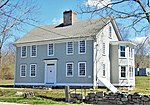Sakonnet River rail bridge
1899 establishments in Rhode IslandBridges completed in 1899Bridges in Newport County, Rhode IslandBuildings and structures demolished in 2007Commons category link is locally defined ... and 8 more
Demolished bridges in the United StatesFormer railway bridges in the United StatesNortheastern United States bridge (structure) stubsOld Colony RailroadRailroad bridges in Rhode IslandRhode Island building and structure stubsSteel bridges in the United StatesSwing bridges in the United States

The Sakonnet River rail bridge was a swing bridge that spanned the Sakonnet River between Portsmouth and Tiverton, Rhode Island, and provided the only rail link between Aquidneck Island and the mainland. It was closed in 1988 and removed in 2006–07
Excerpt from the Wikipedia article Sakonnet River rail bridge (License: CC BY-SA 3.0, Authors, Images).Sakonnet River rail bridge
Riverside Drive,
Geographical coordinates (GPS) Address Nearby Places Show on map
Geographical coordinates (GPS)
| Latitude | Longitude |
|---|---|
| N 41.638926 ° | E -71.2132 ° |
Address
Sakonnet River Bridge
Riverside Drive
02878
Rhode Island, United States
Open on Google Maps










